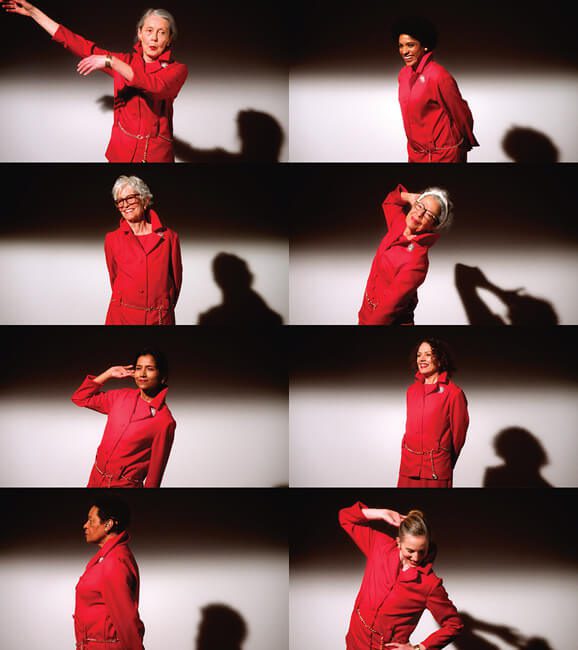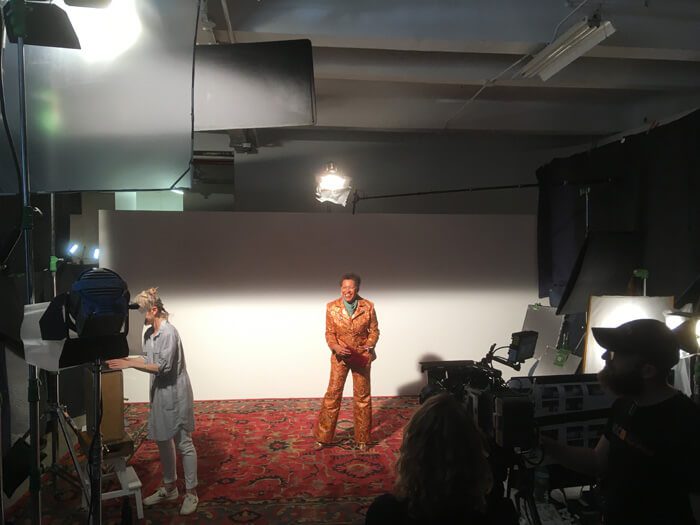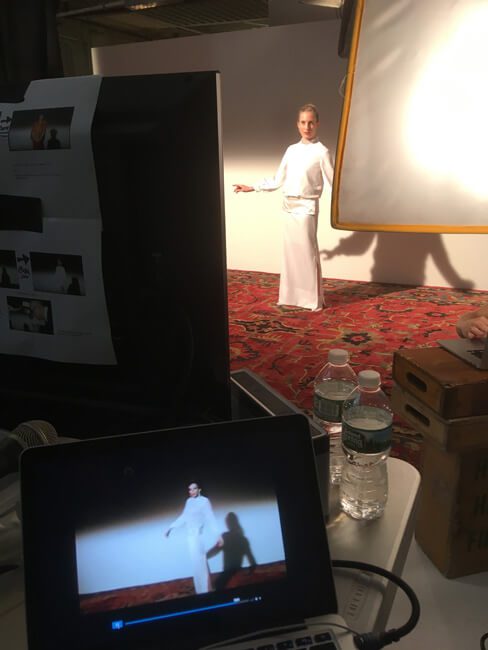Suzanne Bocanegra’s video installation Valley at the Blanton Museum in Austin casts eight famous women artists in a reenactment of Judy Garland’s wardrobe test for Valley of the Dolls.

Valley of the Dolls is known for being a laughably excessive movie about women performers who spin out on pills and booze, exploited and dismissed by the men they love all the way down. The 1967 camp classic is based on one of the best-selling books in publishing history, the so-titled 1966 novel by Jacqueline Susann.
Its overblown aesthetics of doomed glamour and aspirational fame were so beguiling that a ready-to-wear fashion line was made based on the movie’s costumes. And the film’s bargain pack of unmentionables—pornography, abortion, overdoses, suicide—rendered Valley of the Dolls an absolute taboo in the Houston community where artist Suzanne Bocanegra grew up.
“The mothers I knew who did have [the book or movie], they hid it,” Bocanegra said.
Bocanegra didn’t watch Valley of the Dolls until she came across the 1966 footage of Judy Garland’s painfully awkward wardrobe test for the part of Helen Lawson in the movie. In the late stages of addiction, Garland appears obviously intoxicated and unsteady. She laughs in jagged intervals as if she’s plumb out of her mind.
Film director Mark Robson fired Garland just days into on-set production. Three years later, and just three months into her fifth marriage, she died of a barbiturate overdose.

“You see the pictures from her last wedding and you think, ‘Why wasn’t someone rushing her to the hospital?’” Bocanegra says.
The unnamed problem and impending tragedy reflected in Garland’s five-minute wardrobe test inspired a direct reenactment of that scene. Bocanegra’s 2018 video installation Valley opened June 27, 2021, at the Blanton Museum of Art in Austin, Texas, with four panels of seventeen-foot-wide projections enveloping viewers in every clumsy movement and clouded phrase.
Bocanegra filmed poet Anne Carson, choreographer and dancer Deborah Hay, artist Joan Jonas, singer and actor Alicia Hall Moran, actor and activist Tanya Selvaratnam, actor Kate Valk, artist Carrie Mae Weems, and ballet dancer Wendy Whelan performing as Garland. The artist chose these women because they exude a sense of strength.
“I wanted them to be like a Greek chorus commenting on Judy Garland’s life,” Bocanegra says.
Blanton Museum assistant curator Claire Howard, originally from Philadelphia, was home for the holidays in 2018 when she caught a four-part exhibition of Bocanegra’s work including Valley at the Fabric Workshop and Museum where Howard worked briefly just out of college. She remembers watching a loop of the piece for almost an hour.

“I just found it mesmerizing because you try to watch one performer and then you’re kind of comparing her with the performer next to her and noticing all these little differences, even though they’re moving and speaking in sync,” Howard says.
“There’s a moment where they all kind of go, like, ‘Woo!’ They’re supposed to make some arm gesture and kind of whistle at the same time, and it’s super weird when you don’t know why they’re doing this,” she says. “There’s a kind of forced lightheartedness.”
The Fabric Workshop offers a residency and incubation space to encourage artists to work outside their usual media; the studio provides a full staff to support that work. Bocanegra used those resources to recreate Judy Garland’s William Travilla-designed wardrobe for Valley of the Dolls for each of the eight performers.
When a suitable replica of the paisley print on one costume couldn’t be found, artists at the Workshop hand-drew the pattern and silkscreened it into the fabric. They used a black Sharpie to make the carpet they found look more like the one in the screen test. Bocanegra wanted to recreate the scene with as much accuracy as possible, down to the stark half-shadow that looms behind Garland as she wavers and giggles.
Schedules afforded just half a day for each artist to film their part at Bocanegra’s Brooklyn studio. Elizabeth DeMent, a lead artist at Big Dance Theater who helped David Byrne’s musicians learn choreography for the American Utopia stage show, served as movement coach. Each artist could watch a mirrored video of Garland’s wardrobe test projected on the wall as DeMent demonstrated the movements off to the side.
One might assume that learning and performing Garland’s gestures would be most natural for the artists in Valley’s cast who utilize movement in their own work. That’s wrong, says Austin-based experimental choreographer Deborah Hay.
“It was very, very, very hard for me,” she says. “I do not learn movement from looking at other people moving. When I’m teaching, I never demonstrate movement for anyone to be able to shape a movement.”
It was only mimicking Garland’s gestures in the most superficial way, gesture by gesture with DeMent’s help, that Hay could reenact what she found to be a “painful” sequence. “Part of what made it so difficult was that [Garland’s experience] was so foreign to me,” Hay says.
Garland is not alone in the scene, and neither were her reenactors. Crew members and the movie’s director Mark Robson gave the instructions during the wardrobe test. Bocanegra voices Robson in Valley, and the crew is played by the artist’s daughter and two members of the Fabric Workshop staff.
Many different accounts of the day of Garland’s wardrobe test suggest Robson had it out for the embattled actor before the camera started rolling. Would-be co-star Patty Duke, who played emerging singer Neely O’Hara in the movie, told Bruce Vilanch in 2009 that Garland’s call time was 6:30 am and the director kept her waiting until 4 pm while men attending to her kept wine “and other things” flowing nearby.
In any case, Bocanegra says, Garland “desperately wanted the job and she was broke.” The actor kept the costumes tailored for her after she was fired and wore them during her last few years on stage.
Suzanne Bocanegra: Valley continues through September 19, 2021, at the Blanton Museum of Art.



